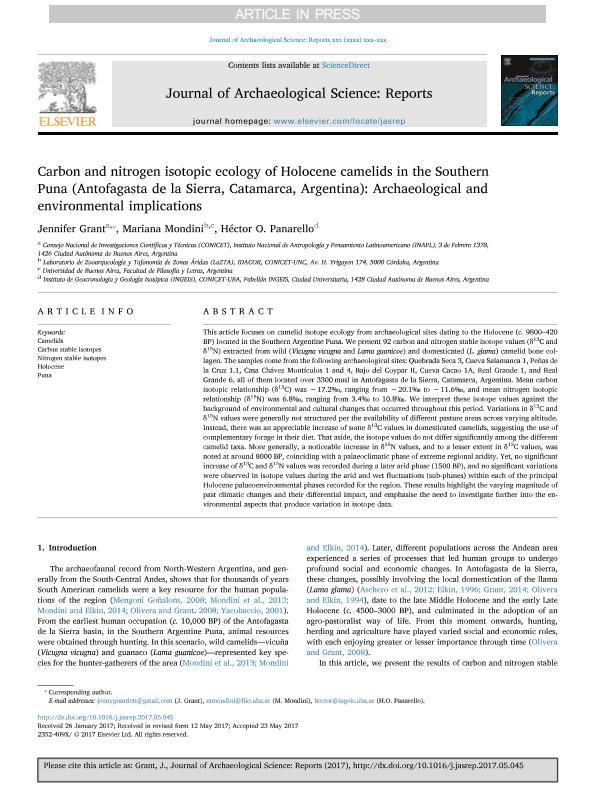Artículo
Carbon and nitrogen isotopic ecology of Holocene camelids in the Southern Puna (Antofagasta de la Sierra, Catamarca, Argentina): Archaeological and environmental implications
Fecha de publicación:
06/2017
Editorial:
Elsevier Science
Revista:
Journal of Archaeological Science: Reports
ISSN:
2352-409X
Idioma:
Inglés
Tipo de recurso:
Artículo publicado
Clasificación temática:
Resumen
This article focuses on camelid isotope ecology from archaeological sites dating to the Holocene (c. 9,800-420 BP) located in the Southern Argentine Puna. We present 92 carbon and nitrogen stable isotope values (δ13C and δ15N) extracted from wild (Vicugna vicugna and Lama guanicoe) and domesticated (L. glama) camelid bone collagen. The samples come from the following archaeological sites: Quebrada Seca 3, Cueva Salamanca 1, Peñas de la Cruz 1.1, Casa Chávez Montículos 1 and 4, Bajo del Coypar II, Cueva Cacao 1A, Real Grande 1, and Real Grande 6, all of them located over 3,300 masl in Antofagasta de la Sierra, Catamarca, Argentina. Mean carbon isotopic relationship (δ13C) was -17.2?, ranging from -20.1? to -11.6?, and mean nitrogen isotopic relationship (δ15N) was 6.8?, ranging from 3.4? to 10.8?. We interpret these isotope values against the background of environmental and cultural changes that occurred throughout this period. Variations in δ13C and δ15N values were generally not structured per the availability of different pasture areas across varying altitude. Instead, there was an appreciable increase of some δ13C values in domesticated camelids, suggesting the use of complementary forage in their diet. That aside, the isotope values do not differ significantly among the different camelid taxa. More generally, a noticeable increase in δ15N values, and to a lesser extent in δ13C values, was noted at around 8,000 BP, coinciding with a palaeoclimatic phase of extreme regional aridity. Yet, no significant increase of δ13C and δ15N values was recorded during a later arid phase (1,500 BP), and no significant variations were observed in isotope values during the arid and wet fluctuations (sub-phases) within each of the principal Holocene palaeoenvironmental phases recorded for the region. These results highlight the varying magnitude of past climatic changes and their differential impact, and emphasise the need to investigate further into the environmental aspects that produce variation in isotope data.
Palabras clave:
Camelids
,
Carbon And Nitrogen Stalbe Isotopes
,
Holocene
,
Puna
Archivos asociados
Licencia
Identificadores
Colecciones
Articulos(IDACOR)
Articulos de INSTITUTO DE ANTROPOLOGIA DE CORDOBA
Articulos de INSTITUTO DE ANTROPOLOGIA DE CORDOBA
Articulos(INGEIS)
Articulos de INST.DE GEOCRONOLOGIA Y GEOLOGIA ISOTOPICA (I)
Articulos de INST.DE GEOCRONOLOGIA Y GEOLOGIA ISOTOPICA (I)
Articulos(SEDE CENTRAL)
Articulos de SEDE CENTRAL
Articulos de SEDE CENTRAL
Citación
Grant Lett Brown, Jennifer Luisa; Mondini, Nora Mariana; Panarello, Hector Osvaldo; Carbon and nitrogen isotopic ecology of Holocene camelids in the Southern Puna (Antofagasta de la Sierra, Catamarca, Argentina): Archaeological and environmental implications; Elsevier Science; Journal of Archaeological Science: Reports; 6-2017; 1-11
Compartir
Altmétricas




